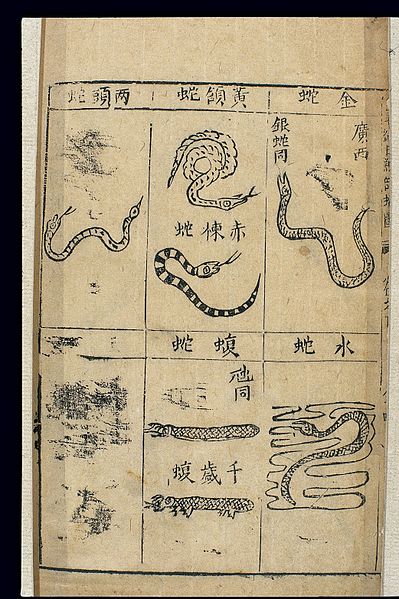File:Bencao Gangmu -- C.16 Chinese materia medica, Snakes Wellcome L0039331.jpg

Original file (2,083 × 3,125 pixels, file size: 5.81 MB, MIME type: image/jpeg)
Captions
Captions
Summary edit
| Bencao Gangmu -- C.16 Chinese materia medica, Snakes | |||
|---|---|---|---|
| Author |
Li Jianyuan (Ming period, 1368-1644) |
||
| Title |
Bencao Gangmu -- C.16 Chinese materia medica, Snakes |
||
| Description |
Li Shizhen's monumental pharmaceutical encyclopediaBencao gangmu(Systematic Materia Medica) contains entries on 1892 medicinal substances and 1109 illustrations. The illustrations in the first edition (shown here) are credited to his son Li Jianyuan.Illustrations of seven types of snake identified asjinshe(gold snake),huanghan she(yellow chin snake),chilian she(red chinaberry snake),liangtou she(two-headed snake), shuishe (water snake),fushe(Pallas pitviper) andqiansui fu(thousand-year-old Pallas pitviper) are grouped together on the same page.According to the text: The gold snake and silver snake belong to the same species of snake, and are named on the basis of their colouring. They are as thick as the middle finger and 30--40cm in length. They are salty in sapor, neutral in thermostatic character, and are non-poisonous. They have the medicinal propertiesof clearing heat and dispelling poisons, reducing inflammation and arresting diarrhoea. They are used in the treatment of abscesses, ulcers and toxic swellings (zhongdu) as well as chronic diarrhoea and dysentery.The yellow chin snake is part yellow and part black, with yellow colouring in the throat area. It grows to 1.5m in length. It feeds on rats, mice and small birds. It is sweet in sapor, cold in thermostatic character,and is slightly poisonous. It has the medicinal properties of removing poisons and curing ulcers, killing parasites and relieving itching. It is used in the treatment of ringworm, persistent itching (wanxuan), malignant ulcers (e chuang), scabies, etc.The red chinaberry snake (orsanggen she, mulberry root snake) is so called because of its alternating red and black segments, which make it resemble the chinaberry or mulberry root. It is sweet in sapor and warm in thermostatic character,and slightly poisonous. It promotes healing and tissue regeneration, and is used in the treatment of unhealed lesions, after the pus has been drained, in scrofula and ulcerative conditions.The two-headed snake is 30--40cm long and the thickness of the little finger. It has a patterned back and bright red underside. The end of the tail resembles a second head, to which it owes its name. It is salty in sapor, neutral in thermostatic character, and is non-poisonous. It has the medicinal properties of relieving ague (jie nüe) and reducing fever, and is used in the treatment of malaria (nüeji).The water snake lives in water and catches and eats fish. It is yellow and black with a spotted back. It is sweet and salty in sapor and cold in thermostatic character, and is non-poisonous. It has the medicinal properties of clearing heat and dispelling poisons, and relieving distress and thirst; and is used in the treatment of wasting thirst (xiaoke, diabetes etc.), fever and distress, bone abscesses in children, etc.The pallas pitviper was known by the ancients ashui. The body of this snake is yellow and black or grey-brown, like the colour of soil. The head is pointed and triangular. It is sweet in sapor, cold in thermostatic character,and is extremely poisonous. It has the medicinal properties of killing parasites and curing sores, and is used in the treatment of ringworm, persistent itching (wanxuan), scabies, malignant ulcers, etc. There is also a species known as the thousand-year-old Pallas pitviper, which has a small body and four limbs, and can leap at people and attack them. Its bite is invariably fatal. It must be distinguished from the common pitviper. By: Li Jianyuan (Ming period, 1368-1644) |
||
| Credit line |
|
||
| Notes | Wellcome Images | ||
| References |
|
||
| Source/Photographer |
https://wellcomeimages.org/indexplus/obf_images/84/90/21b3d09668eecd72751b863ace77.jpg (hi-res image)
|
||
Licensing edit
- You are free:
- to share – to copy, distribute and transmit the work
- to remix – to adapt the work
- Under the following conditions:
- attribution – You must give appropriate credit, provide a link to the license, and indicate if changes were made. You may do so in any reasonable manner, but not in any way that suggests the licensor endorses you or your use.
File history
Click on a date/time to view the file as it appeared at that time.
| Date/Time | Thumbnail | Dimensions | User | Comment | |
|---|---|---|---|---|---|
| current | 14:59, 12 July 2014 |  | 2,083 × 3,125 (5.81 MB) | Faebot (talk | contribs) | Crop bottom 26 pixels to remove watermark (2083x3125) |
| 13:54, 12 July 2014 |  | 2,083 × 3,151 (2.92 MB) | Fæ (talk | contribs) | {{watermark}} =={{int:filedesc}}== {{Artwork |artist = |author =Li Jianyuan (Ming period, 1368-1644) |title =Bencao Gangmu -- C.16 Chinese materia medica, Snakes |description =Li Shizhen's monumental pharmace... |
You cannot overwrite this file.
File usage on Commons
The following page uses this file:
